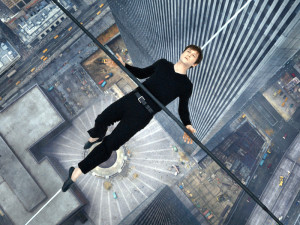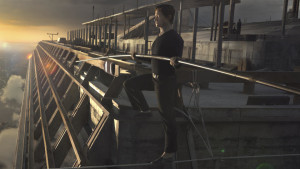In Robert Zemeckis’ The Walk, what Philippe Petit did when he crossed the Twin Towers, back in 1974, on a tightrope is rightfully painted as achieving so much more than an astonishing death-defying feat. As Zemeckis establishes in his film, Petit was in love with the World Trade Center and the Forrest Gump and Flight filmmaker’s work also serves as a love letter to the towering buildings whose existence ended tragically in 2001.
Joseph Gordon Levitt is Petit, a French acrobatic artist who made his living performing in the streets of Paris. Upon seeing a rendering of the Twin Towers in a newspaper, he immediately falls in love. He says they called to him, in a perfectly handled narration that he delivers throughout the film from next to the flame above the Statue of Liberty with the towers towering over him across the river.
But before he attempts something as radical as crossing between the North Tower and the South Tower on an inch-wide wire, he needs to make a name for himself making a similar type of daredevil move in his home city. Petit would go into the towers of the Notre Dame late at night with his best friend and manage to lay a wire that he would cross in the morning at dawn with all of Paris watching from the streets below. The French people would marvel at his accomplishment, but the newspapers would call him a vandal… and that does not sit well with the flamboyant high flyer.
In the same newspaper that would call him that rebellious name, he finds an article on the opening of the Twin Towers and he sees it as a sign. Petit is now a man on a mission.
Zemeckis’ film at that point truly takes off. It plays like a heist movie in the way that everything Petit does has to be done in the shadows. It’s not like he can legally cross the Twin Towers and since they are not fully open yet, time is of the essence for him and his crew to accomplish his coup (as he entitles it) of accomplishing something that the world will talk about for weeks, if not years!
Gordon-Levitt is fantastic as Petit. One of The Movie Mensch’s pet peeves is when American actors play French citizens speaking English with a Franco-ized accent. But, Gordon-Levitt truly nails it and within moments of him speaking, the viewer forgets that the actor is attempting a difficult accent. Zemeckis and his co-screenwriter Christopher Browne also do a fantastic job of explaining why these French men and women would be speaking English. Another pet peeve of ours — watching two foreigners speak in English when they truly have no reason to. The reason here… all involved are going to America for this coup, and they have to pass for solid talking English-speakers.
The filmmaker surrounds Gordon-Levitt with an electric ensemble who all rise to the occasion of telling this true and touching tale. Particularly stunning is Charlotte Le Bon. The French-Canadian actress charms as Petit’s girlfriend and biggest supporter who challenges him and also pulls him up when he suffers doubt that what he is doing is undoable. Sir Ben Kingsley is his usual awesome self as Papa Rudy, the Eastern European tightrope master who mentors Petit and coaches him in his effort to accomplish a feat that would easily go down as the greatest high-wire act of all time.
Where The Walk truly astounds is in its final act, when Petit actually heads out on that wire, high above Manhattan, walking between two of the largest buildings in the world (at that time). Zemeckis shot his film in IMAX 3D and it is stunning. For those who are even a little afraid of heights, prepare to have your hands shake a little. The viewer truly feels as if they are out there on the thin wire, one hundred stories above the streets of New York City. It is an extraordinary vision and an amazing cinematic accomplishment.
Above all else — as we said — The Walk is a love letter to the World Trade Center. When they were first erected, Manhattanites were not so taken with the Twin Towers. In the film one even describes them as two giant file cabinets. After Petit comes down from his perch, one New York police officer pats him on the shoulder and tells him that he’s “done good. You brought the towers to life.” Zemeckis and his filmmaking team never mention 9/11 or the horrible demise of those glorious buildings. But with that one quote, the audience’s mind is allowed to craft their own memories of the WTC and bookend their existence with Petit’s walk and the day America was attacked.
And what may be Zemeckis’ most glorious visual shot is the film’s final one. It’s as touching of a tribute to the Twin Towers as could be, and don’t be surprised if the emotions flow as the screen goes dark.
You can see why this film is a slam dunk for our 15 finest films of fall!
Grade: A-



